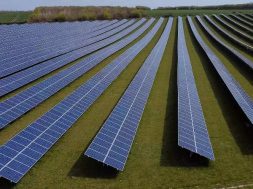III–V-on-silicon solar cells reaching 33% photoconversion efficiency in two-terminal configuration
Abstract
Silicon dominates the photovoltaic industry but the conversion efficiency of silicon single-junction solar cells is intrinsically constrained to 29.4%, and practically limited to around 27%. It is possible to overcome this limit by combining silicon with high-bandgap materials, such as III–V semiconductors, in a multi-junction device. Significant challenges associated with this material combination have hindered the development of highly efficient III–V/Si solar cells. Here, we demonstrate a III–V/Si cell reaching similar performances to standard III–V/Ge triple-junction solar cells. This device is fabricated using wafer bonding to permanently join a GaInP/GaAs top cell with a silicon bottom cell. The key issues of III–V/Si interface recombination and silicon’s weak absorption are addressed using poly-silicon/SiO x passivating contacts and a novel rear-side diffraction grating for the silicon bottom cell. With these combined features, we demonstrate a two-terminal GaInP/GaAs//Si solar cell reaching a 1-sun AM1.5G conversion efficiency of 33.3%.
Source: nature
Related posts:
- REC Silicon -Presentation at the Swedbank Energy Summit
- Seeing the Light: Researchers Seek to Improve Solar Cell Technology Using New Materials and Nanowires
- Meyer Burger awarded strategic contracts with a combined order volume of about CHF 14 million for its industrialised diamond wire based DW 288 Sapphire cutting system
- Blue World Technologies acquires globally recognised manufacturer of fuel cell components to strengthen its market position










